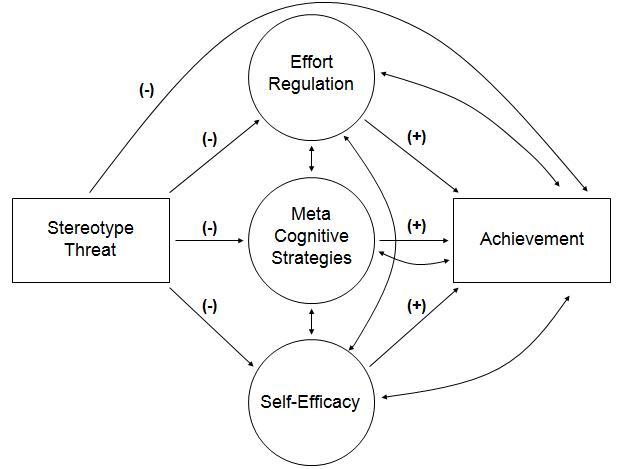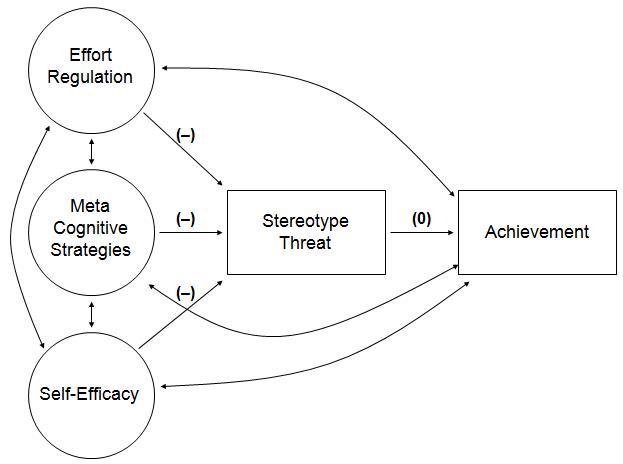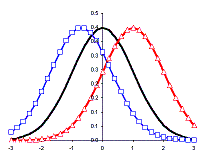| Vitae | Goal Statement | Coursework | Analytical & Integrated Thinking | Research | Professional Experiences | Dissertation Planning |
Analytical & Integrated Thinking: Portfolio II
Self-regulation and
motivation has played a strong role in shaping my research interests.
Even
after five years those constructs have continued to be the main focus
of my
research. However, as I am exposed to
more issues and theories in education, my interests in self-regulation
and
motivation has been refined to include stereotype effects. Therefore, I
need to
find a way to integrate these two fields.
To my current
knowledge, researchers have yet to find an explanation on why exactly
stereotype threat causes a decrease in achievement. However, research
has
suggested that social cognitive constructs such as learning strategies
and
self-efficacy may be the mediating/moderating link between stereotype
threat
and achievement. Specifically, the literature on stereotype threat
indicates
that negative stereotypes that are socially inflicted upon one’s
ability to
achieve actually impede achievement (Aronson & Inzlicht, 2004;
Aronson
& Steele, 2005; Steele & Aronson, 1995; Steele, 1997). If
social-cognitive theory asserts that our behaviors and cognitions are
partially
the products of the social environment, and if stereotypes are social
in
nature, then theoretically, social cognitive variables can be expected
to
influence the impact of stereotypes.
Schmader et al. (2008) provides a model of understanding how self-regulation may impact the processes in stereotype threat that hinder performance. Specifically, Schmader et al. (2008) argue that students who experience stereotype threat are constantly monitoring their environment and situational cues to understand what is implied about the self and/or group. Additionally, Schmader et al. (2008) suggest that working memory is required for one to effectively self-control or self-regulate their behaviors and cognitions. Therefore, if working memory is hindered, the ability to self-regulate and to metacognitively reflect about the task is also hindered. Additionally, because stereotype threat is associated with an increased cognitive load and awareness of stigma that is associated with the particular social group, this may also impact motivational factors such as self-efficacy, where the student’s competency beliefs are impacted (Hollins-Sawyer & Sawyer, 2008).
Therefore, current research is beginning to recognize how certain educational psychology constructs such as self-regulation and motivation can mediate and moderate stereotype threat effects. However, researchers have yet to use social cognitive theory as the main theoretical framework for examining the cognitive/behavioral learning aspect in stereotype threat.
As a result, I propose the following integrative model of stereotype threat, self-regulation, and achievement:
Figure I. Stereotype threat effects on student achievement when students are not trained in self-regulated learning. The model suggests that when students do not know how to strategically self-regulate their learning, stereotype threat negatively impacts self-regulated learning, which causes lower student achievement. In other words, self-regulation partially mediates the relationship between stereotype threat and achievement.

Figure 2.Stereotype threat effects on student achievement when students are trained in self-regulated learning. The model suggest that when students know how to regulate their learning, those processes negatively impact stereotype threat effects which results in eliminating its effect on achievement.

Analytical & Integrated Thinking: Portfolio I
The purpose of this section is to delineate how my thinking has evolved over the course of my PhD studies and to provide evidence of analytical and integrative thinking through different artifacts. As discussed in my goals statements and course reflections, I was introduced to the idea of Critical Race Theory during my first semester as a PhD student. Understanding of that theory has changed my entire perspective on education and social justice. However, I had difficulty trying to bridge ideas of Critical Race Theory with educational psychology and research. Therefore, I looked deeper into the concepts and literature and discovered the idea of stereotype threat. These three papers from my first and second semester of studies show how I conceptualized stereotype beliefs and my hypothesized model of how it is related to motivation, self-regulation, and achievment. As I learned more about stereotypes, I refined my model during my second semester of studies. However, during my third and current semester of studies, I just happened to stumble upon a term called "stereotype internalization." This term along with stereotype consciousness was a concept that I was trying to conceptualize myself as stereotype beliefs. Therefore, from this point on, I will focus on the idea of stereotype consciousness and internalization as concepts that will guide my thinking.
Semester 1:
Ways of Knowing Synthesis Paper: This final paper required students to reflect on a specific theory discussed in class in terms of how it has transformed the way we think, feel, and know about how different people understand the world. I selected Critical Race Theory as my main topic. Specifically, my understanding of Critical Race Theory has not only influenced my research interests, but has also influenced my life and the way I understand the world. This course has set the stage for my studies and will influence my dissertation topic as well as future work.
SocioCultural Perpectives Final Paper: The purpose of this paper was to develop a proposal that examined a sociocultural aspect in education. This course was taken concurrently with my Ways of Knowing course, which complimented each other very nicely. Specifically, in the Ways of Knowing course, I was introduced to elaborate theories of race, while in the SocioCultural course, I was taught how to conduct research on sociocultural relations. Therefore, with this final paper, I was able to select a topic relevant to my interests in race (perceived stereotypes) as well as an educational aspect (motivation and self-regulation) and view it from a Critical Race perspective. I am very glad that I had taken these two classes together because it helped me integrate my ideas from theory (Critical Race Theory) to practice (research).
Semester
2:
Learning and Motivation Final Paper:
The purpose of this
paper was to develop a proposal that examined an aspect of learning and
motivation. However, I did not feel prepared to develop a proposal
because of
my lack of understanding of stereotypes. Specifically, for my proposal
in
SocioCultural Perspectives, I had written about a concept I called
perceived
stereotypes and stereotype beliefs. However, my concept of perceived
stereotypes
lacked a strong theoretical framework and I needed to build on my idea
and try
to understand what I was thinking more. Therefore, I decided to write a
literature review on the idea of stereotypes to explore what is
currently
present in the literature about beliefs about different stereotypes and
the
implications that it may have on how stereotypes, motivation, and
self-regulation may be related.
